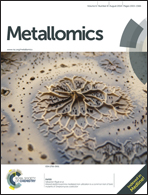Oxidative damage to rat brain in iron and copper overloads
Abstract
This study reports on the acute brain toxicity of Fe and Cu in male Sprague-Dawley rats (200 g) that received 0 to 60 mg kg−1 (ip) FeCl2 or CuSO4. Brain metal contents and time-responses were determined for rat survival, in situ brain chemiluminescence and phospholipid and protein oxidation products. Metal doses hyperbolically defined brain metal content. Rat survival was 91% and 60% after Fe and Cu overloads. Brain metal content increased from 35 to 114 μg of Fe per g and from 3.6 to 34 μg of Cu per g. Brain chemiluminescence (10 cps cm−2) increased 3 and 2 times after Fe and Cu overloads, with half maximal responses (C50) of 38 μg of Fe per g of brain and 15 μg of Cu per g of brain, and with half time responses (t1/2) of 12 h for Fe and 20 h for Cu. Phospholipid peroxidation increased by 56% and 31% with C50 of 40 μg of Fe per g and 20 μg of Cu per g and with t1/2 of 9 h and 14 h. Protein oxidation increased by 45% for Fe with a C50 of 40 μg of Fe per g and 18% for Cu with a C50 of 10 μg of Cu per g and a t1/2 of 12 h for both metals. Fe and Cu brain toxicities are likely mediated by Haber–Weiss type HO˙ formation with subsequent oxidative damage.


 Please wait while we load your content...
Please wait while we load your content...